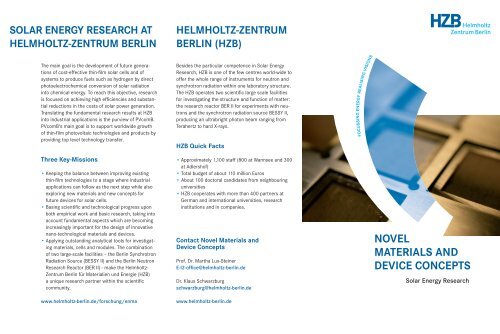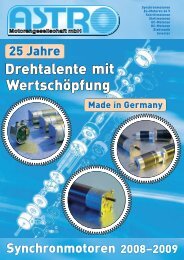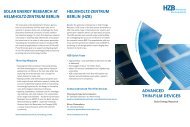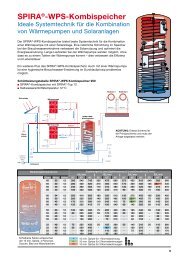helMholtz-zeNtruM BerliN (hzB) - EXPO21XX.com
helMholtz-zeNtruM BerliN (hzB) - EXPO21XX.com
helMholtz-zeNtruM BerliN (hzB) - EXPO21XX.com
Create successful ePaper yourself
Turn your PDF publications into a flip-book with our unique Google optimized e-Paper software.
solar eNergy research at<br />
<strong>helMholtz</strong>-<strong>zeNtruM</strong> <strong>BerliN</strong><br />
The main goal is the development of future generations<br />
of cost-effective thin-film solar cells and of<br />
systems to produce fuels such as hydrogen by direct<br />
photoelectrochemical conversion of solar radiation<br />
into chemical energy. To reach this objective, research<br />
is focused on achieving high efficiencies and substantial<br />
reductions in the costs of solar power generation.<br />
Translating the fundamental research results at HZB<br />
into industrial applications is the purview of PV<strong>com</strong>B.<br />
PV<strong>com</strong>B‘s main goal is to support worldwide growth<br />
of thin-film photovoltaic technologies and products by<br />
providing top level technology transfer.<br />
three Key-Missions<br />
• Keeping the balance between improving existing<br />
thin-film technologies to a stage where industrial<br />
applications can follow as the next step while also<br />
exploring new materials and new concepts for<br />
future devices for solar cells.<br />
• Basing scientific and technological progress upon<br />
both empirical work and basic research, taking into<br />
account fundamental aspects which are be<strong>com</strong>ing<br />
increasingly important for the design of innovative<br />
nano-technological materials and devices.<br />
• Applying outstanding analytical tools for investigating<br />
materials, cells and modules. The <strong>com</strong>bination<br />
of two large-scale facilities – the Berlin Synchrotron<br />
Radiation Source (BESSY II) and the Berlin Neutron<br />
Research Reactor (BER II) - make the Helmholtz-<br />
Zentrum Berlin für Materialien und Energie (HZB)<br />
a unique research partner within the scientific<br />
<strong>com</strong>munity.<br />
www.helmholtz-berlin.de/forschung/enma<br />
<strong>helMholtz</strong>-<strong>zeNtruM</strong><br />
<strong>BerliN</strong> (<strong>hzB</strong>)<br />
Besides the particular <strong>com</strong>petence in Solar Energy<br />
Research, HZB is one of the few centres world-wide to<br />
offer the whole range of instruments for neutron and<br />
synchrotron radiation within one laboratory structure.<br />
The HZB operates two scientific large scale facilities<br />
for investigating the structure and function of matter:<br />
the research reactor BER II for experiments with neutrons<br />
and the synchrotron radiation source BESSY II,<br />
producing an ultrabright photon beam ranging from<br />
Terahertz to hard X-rays.<br />
<strong>hzB</strong> Quick Facts<br />
• Approximately 1,100 staff (800 at Wannsee and 300<br />
at Adlershof)<br />
• Total budget of about 110 million Euros<br />
• About 100 doctoral candidates from neighbouring<br />
universities<br />
• HZB cooperates with more than 400 partners at<br />
German and international universities, research<br />
institutions and in <strong>com</strong>panies.<br />
contact Novel Materials and<br />
device concepts<br />
Prof. Dr. Martha Lux-Steiner<br />
E-I2-office@helmholtz-berlin.de<br />
Dr. Klaus Schwarzburg<br />
schwarzburg@helmholtz-berlin.de<br />
www.helmholtz-berlin.de<br />
FocussiNg eNergy realisiNg visioNs<br />
Novel<br />
Materials aNd<br />
device coNcepts<br />
Solar Energy Research
Novel Materials aNd<br />
device coNcepts<br />
Research in Novel Materials and Device Concepts is directed toward<br />
the long-term goal of producing cost-effective and more efficient<br />
devices. As an example, solar cell concepts based on nanoparticles<br />
promise to provide extended chemical flexibility and exploit quantum-size<br />
and optical coherence effects. The aim is to generate the<br />
scientific knowledge needed to create photovoltaic devices beyond<br />
the present cost and efficiency limitations.<br />
Efficiencies beyond the Shockley-Queisser limit for single band gap<br />
materials have so far only been observed for multijunction devices<br />
using stacks of III-V materials with different band gap energies.<br />
In recent years, a wide variety of theoretical concepts have been<br />
discussed to make use of novel photovoltaic concepts to exceed fundamental<br />
efficiency limits by minimising spectral and thermalisation<br />
losses without using multijunction cells.<br />
Scientific approaches are employed to systematically over<strong>com</strong>e fundamental<br />
challenges governing efficiency limits as well as addressing<br />
practical requirements such as the desire to use low-cost materials.<br />
For this purpose we make use of a <strong>com</strong>bination of materials that are<br />
already in an advanced stage of development (in particular materials<br />
for advanced thin-film devices) and of materials and concepts (such<br />
as hybrid devices) that up to now have been investigated primarily on<br />
fundamental levels.<br />
Ga<br />
Cu<br />
Fe<br />
S<br />
research topics<br />
Materials<br />
• New photovoltaic materials (e.g. kesterite (CZTS),<br />
Cd-free buffer layer for chalcopyrite solar cells)<br />
• Materials for intermediate-bandgap solar cells<br />
• Organic layers for the passivation of Si surfaces<br />
• Evaporated hybrid solar cells<br />
Devices<br />
• High-efficiency tandem chalcopyrite-type devices<br />
• (Nano-) point contacts for chalcopyrite devices<br />
• Enhanced absorption through plasmonic light coupling<br />
• Intermediate band-gap solar cells<br />
• Quantum-dot structures for solar cells based on Si<br />
projects & co-operations (selection)<br />
• IBPower – thin-film materials for intermediate band solar cells (EU)<br />
• NanoPV - Nanomaterials and nanotechnology for advanced<br />
Photovoltaics (EU)<br />
• NanoPV - Nanopartikuläre Dünnschicht-Solarzellen<br />
- Grundlagen & Prozesstechnologie (BMBF)<br />
• Nanoskalige III-V Silizium Heterostrukturen für hocheffiziente<br />
Solarzellen (BMBF Innovationsallianz)<br />
• Neukosolar – Neuartige Kontaktsysteme für Solarzellen<br />
(IBB/EFRE)<br />
• Pinet – PIN- Solar cells based on alternative absorber<br />
and contact materials (BMBF)<br />
• SINOVA – Siliziumbasierte nanostrukturierte<br />
Dünnschichtmaterialien (BMBF)<br />
Crystal lattice of CuGaS with partial substitution of Fe for Ga Cross section of the angular power distribution of light<br />
Silicon nanodots grown on an oxidised Si-wafer (large picture taken at 30° angle, small<br />
2<br />
radiated by a dipole at the interface air - ZnO:Al<br />
picture at 90°)









